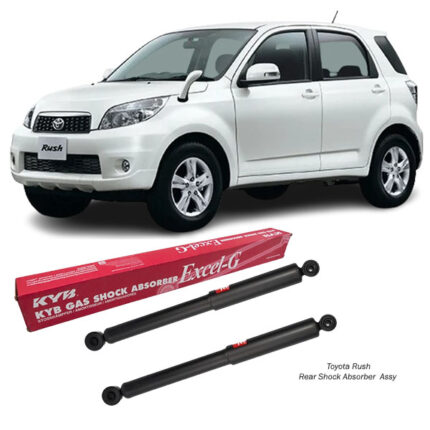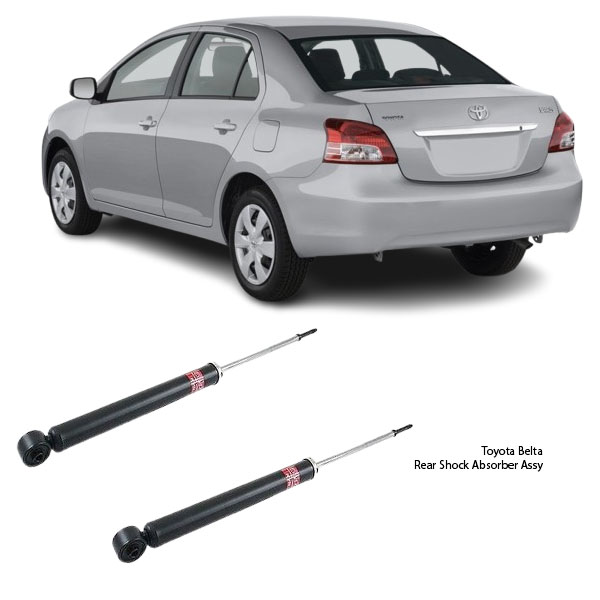-8%
Get Toyota Belta Rear Shock Absorber Assy 343442 in Kenya
Tucked away behind the scenes, doing its job with quiet precision, the Rear Shock Absorber Assembly is one of the most crucial components when it comes to comfort, balance, and stability — especially where it often matters most: the rear. Whether you’re cruising smooth or rolling over rough patches, this assembly keeps everything planted, predictable, and peaceful. 🛠️💨
What Is a Rear Shock Absorber Assy? 🌀
The Rear Shock Absorber Assy is a complete unit built to manage vertical motion, absorb impact, and control the movement of the rear suspension. It’s a key player in how everything reacts to surface conditions and shifting weight — maintaining smoothness, keeping motion in check, and helping distribute energy evenly.
Typically, it includes:
-
A shock absorber (also known as a damper) 🛑
-
A coil spring (if part of a strut or coil-over design) 🌀
-
Mounting hardware and bushings that absorb vibration and hold the system firmly in place 🔩
Together, this assembly ensures the rear end doesn’t bounce, dip, or sway unpredictably — giving you a sense of security and control, especially when the road says otherwise.
The Purpose of the Rear Shock Absorber 🔍
While the front takes the lead in handling direction and responsiveness, the rear handles weight distribution, stability, and follow-through. That makes the rear shock absorber assembly vital — especially under shifting loads or sudden changes in terrain. 🌧️🌄
Its job includes:
-
Absorbing bumps and uneven surfaces 💥
-
Reducing body bounce, squat, or sway 🚫
-
Keeping everything level, especially when carrying extra weight 🧳
-
Ensuring consistent contact with the ground 👣
-
Helping maintain safe handling in tight turns or uneven conditions 🎯
Without it, every ripple, dip, or bump would be felt far more intensely — affecting the whole experience.
How It Works ⚙️
Here’s what happens when things get bumpy:
-
Shock Absorber Action 🛠️
Hydraulic fluid inside the cylinder resists motion. As the rear end moves up and down, the fluid flows through precision valves, slowing the motion and absorbing energy. -
Spring Compression 🌀
If there’s a spring involved (common in strut-style assemblies), it compresses to absorb the impact, then rebounds to help return everything to normal height. -
Mounts and Bushings 💡
These parts isolate vibration and noise, allowing motion where it’s needed while keeping metal parts from grinding or rattling.
This whole setup works as a unit — dampening motion, softening impact, and keeping everything calm and controlled.
The Experience It Delivers 💺
The rear shock absorber assembly might not be something you see or think about often, but you definitely feel the difference when it’s doing its job.
✅ Smooth rides over rough surfaces
✅ Reduced bounce on hilly roads
✅ Better traction when the path gets unpredictable
✅ Confident control when carrying or shifting weight
From solo commutes to packed adventures, the rear shock absorber helps keep it all balanced and stable — every time.
Signs It Might Need Attention 👀
Over time, constant motion, exposure to the elements, and internal wear can take a toll. Here’s how to spot a rear shock absorber assembly that’s asking for help:
-
Increased bounce after bumps ⬆️⬇️
-
A sagging or uneven rear stance 📏
-
Knocking or clunking sounds from the back 🔊
-
Difficulty maintaining grip on rough or slick surfaces 🌀
-
More body sway during turns or quick stops 🌀💫
-
Fluid leaks on the shock body 💧
Spotting these signs early means avoiding uneven wear, poor control, and discomfort.
The Quality Difference 🏆
Not all shock absorber assemblies are created equal. A well-built rear shock assembly gives you:
-
Consistent performance in all conditions
-
Durability for the long haul
-
Responsive damping that adjusts to the terrain
-
Quiet, smooth operation from quality bushings and seals
High-quality components mean fewer replacements, better handling, and a smoother ride — day in, day out. 🌅
Common Types of Rear Shock Absorber Assemblies 🔄
Depending on the design, different assemblies offer different benefits:
-
Twin-Tube: Two cylinders for balanced, reliable damping. A common and cost-effective design.
-
Mono-Tube: Single cylinder with high-pressure gas — great for performance and responsiveness.
-
Gas-Charged: Adds pressurized gas to prevent foaming and improve control.
-
Strut Assemblies: Combine the shock and structural support — often with a spring attached.
-
Air Shocks: Adjustable air pressure to fine-tune load handling.
Each is suited for different setups and driving needs. 🔧💬
Why Installation Matters 🧰
Replacing a rear shock absorber assembly isn’t just plug-and-play. It requires proper tools, alignment knowledge, and an understanding of how the suspension system fits together.
Improper installation can lead to:
-
Misalignment
-
Uneven ride height
-
Premature wear
-
Safety issues ⚠️
That’s why it’s best left to trained technicians who can do the job right the first time.
Maintenance Tips 🔍
While shock absorber assemblies are mostly maintenance-free, regular checks can help you get the most out of them:
-
Inspect for leaks or oil stains
-
Check for dents or corrosion on the body
-
Look for worn or cracked bushings
-
Listen for unusual noises during motion
Catch any issues early and your ride will thank you. 🙌
The Bottom Line 🧠
The Rear Shock Absorber Assembly plays a huge role in how everything feels, reacts, and handles — especially when conditions get less than ideal. It’s the quiet champion of comfort and control, taking on every bump, dip, and twist from behind the scenes.
When everything is working as it should, you glide confidently through the journey. And when it’s time for a replacement, going with a high-quality assembly and expert installation keeps that smooth experience going strong. 🚀
Strong. Stable. Smooth. That’s the promise of a good rear shock absorber assembly.
Follow us on Facebook for more parts.



